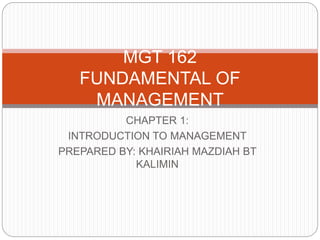
Chapter_1_Introduction_to_Management_Cop.pptx
- 1. MGT 162 FUNDAMENTAL OF MANAGEMENT CHAPTER 1: INTRODUCTION TO MANAGEMENT PREPARED BY: KHAIRIAH MAZDIAH BT KALIMIN
- 2. CHAPTER 1: INTRODUCTION OF MANAGEMENT Learning Outlines 1.1 Definition of management and organization 1.2 Measuring managerial performance 1.3 Management process, functions and activities 1.4 Managerial levels, skills and roles 1.5 Evolutions of management thoughts
- 3. ORGANIZATION Made up from 2 or more people that is goal directed and deliberately structured 1.1 DEFINITION OF MANAGEMENT AND ORGANIZATION MANAGEMENT The process of planning, organizing, leading and controlling resources to achieve organizational goals effectively and efficiently.
- 5. 1.2 MEASURING MANAGERIAL PERFORMANCE EFFICIENCY - The ability to get things done correctly - Doing things right - Ex: minimize the cost, input- ouput concept EFFECTIVENESS - Ability to choose appropriate objectives - Doing the right things - Ex: Goal attainment
- 6. 1.3 MANAGEMENT PROCESS, FUNCTIONS AND ACTIVITIES PLANNING - Defining goals, establishing strategy, and developing plans to coordinate activities ORGANIZING - Determine what task, who & how, who report to whom & where decision to be made LEADING - Motivating, select effective communication channels & resolving conflict CONTROLLING - Monitoring activities and correcting any significant deviation
- 7. 1.4 MANAGERIAL LEVELS, SKILLS AND ROLES
- 9. 1. First-line managers/ lower level manager - Direct operating employees only, they do not supervise other managers. 2. Middle manager - Direct the activities that implement their organization policies - Balance the demands of their superiors with the capacity of their subordinates. 3. Top managers - Responsible for the overall management of the organization. - Establish operating policies & guides the organization’s interactions with its environment.
- 10. MANAGERIAL SKILL
- 11. What is Role? - The behavior that is expected in a particular situation. ROLE OF MANAGERS Interpersonal roles •Figurehead •Leader •liaison Informational Roles •Monitor •Disseminator •Spokesperson Decisional roles •Entrepreneur •Disturbance Handler •Resource Allocator •Negotiators
- 12. FACTOR INFLUENCING MANAGEMENT THOUGHTS 1.5 EVOLUTION OF MANAGEMENT THOUGHTS Economic Influences The availability, production, and distribution of resources within a society. Social Influences The aspects of a culture that influence interpersonal relationships.
- 13. Political Influences The impact of political institutions on individuals and organizations. Technological Influences The advances and refinements in any of the devices that are used in conjunction with conducting business. Global Influences The pressures to improve quality, productivity, and costs as organizations attempt to compete in
- 14. Chronological Development of Management Perspectives
- 15. Classical approach to management resulted from the first significant, concentrated effort to develop a body of management thought. Management writers who participated in this efforts are considered the pioneer of management study A) CLASSICAL PERSPECTIVES
- 16. Subfields of the Classical Perspective on Management Focuses on the individual worker’s productivity Focuses on the overall organizational system Focuses on the functions of management
- 17. Introduced by Frederick Winslow Taylor. Focus on increasing the efficiency of production processes in order to enhance organizational productivity. Introduced differential rate compensation system whereby more productive workers received a higher pay rate. Scientific Management
- 18. Three areas of focus: Task Performance Supervision Motivation Continue…
- 19. Henri Fayol (1841–1925) First recognized that successful managers had to understand the basic managerial functions. Developed a set of 14 general principles of management. Fayol’s managerial functions of planning, leading, organizing and controlling are routinely used in modern organizations. To find the principles and guidelines for determining how to manage systematically and effectively. Administrative management
- 20. Focuses on the overall organizational system. Bureaucratic management is based upon: Firm rules Policies and procedures A fixed hierarchy A clear division of labor Bureaucratic management
- 21. Followed the classical perspective in the development of management thought. Acknowledged the importance of human behavior in shaping management style Is associated with: Elton Mayo Douglas McGregor Mary Parker Follet Chester Barnard B) BEHAVIORAL PERSPECTIVE
- 22. • Characterized by its use of mathematics, statistics, and other quantitative techniques for management decision making and problem solving. • This approach has four basic characteristics: 1. A decision-making focus 2. Development of measurable criteria 3. Formulation of a quantitative model 4. The use of computers C) QUANTITATIVE APPROACH
- 23. Decision-Making Focus The primary focus of the quantitative approach is on problems or situations that require direct action, or a decision, on the part of management. Measurable Criteria The decision-making process requires that the decision maker select some alternative course of action.
- 24. Quantitative Model To assess the likely impact of each alternative on the stated criteria, a quantitative model of the decision situation must be formulated. Computers Computers are quite useful in the problem-solving process.
- 25. Views the organization as a unified, directed system of interrelated parts. The systems sees each change in a part of the system as having an impact on all others parts. The system helps managers to realize that every action has consequences somewhere inside as outside the organization. D) SYSTEM PERSPECTIVE
- 26. A view that proposes that there is no one best approach to management for all situations. Asserts that managers are responsible for determining which managerial approach is likely to be most effective in a given situation. This requires managers to identify the key contingencies in a given situation. E) CONTINGENCY PERSPECTIVE
- 27. THE END